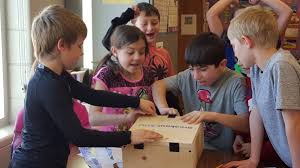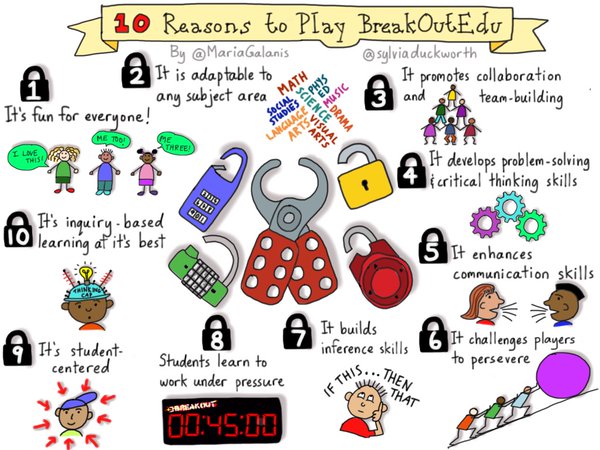Breakout EDU- Activating Collaboration & Critical Thinking
Author: Rick Phelan
Published: 12.03.16
 Critical thinking and collaboration are key skills for 21st century citizens. Working to promote these skills, McKinley Elementary School teacher Matthew De Lucia-Zeltzer (Mr. D-Z) has been providing ‘Breakout EDU’ activities with his 4th & 5th grade students. Breakout EDU is a new game based activity where students collaborate to solve puzzles and unlock codes within a 45 minute time period. Finding answers to ‘Breakout EDU’ activities requires brainstorming and teamwork to arrive at solutions. This blog post describes Mr. D-Z’s Breakout EDU game efforts with students at McKinley Elementary School.
Critical thinking and collaboration are key skills for 21st century citizens. Working to promote these skills, McKinley Elementary School teacher Matthew De Lucia-Zeltzer (Mr. D-Z) has been providing ‘Breakout EDU’ activities with his 4th & 5th grade students. Breakout EDU is a new game based activity where students collaborate to solve puzzles and unlock codes within a 45 minute time period. Finding answers to ‘Breakout EDU’ activities requires brainstorming and teamwork to arrive at solutions. This blog post describes Mr. D-Z’s Breakout EDU game efforts with students at McKinley Elementary School.
Breakout EDU games are available for people of all ages including adults. Each game is centered around a Breakout EDU box with players having a set amount of time to open the box. During a game players navigate a series of mysteries looking at clues to solve engaging problems. Games feature a blend of physical and online puzzles. The Breakout EDU website (http://www.breakoutedu.com/) provides materials and resources to get started.
Mr. D-Z became interested in Breakout EDU activities after an introductory Breakout EDU activity with his class. He was impressed by the game based format offering hands-on critical thinking activities. Mr. D-Z saw value in the ‘real world skills’ of thinking and collaboration with Breakout EDU activities. He wondered how students could increase their soft skill abilities such as interpersonal communication, empathy, problem solving and teamwork. He noted that his students understood ideas of competition and individual achievement but needed improvement in their collaborative skills.
Specific character traits Mr. D-Z wants to tap and develop through Breakout EDU activities:
- Leadership
- Compassion
- Collaboration
- Empathy
- Trust
To do this, Mr. D-Z resolved to do four Breakout EDU activities with his class during the 2016-17. Whole class Breakout EDU activities were planned for 2016-17 in September, November, February and May where his class would be divided into teams of 5-6 students. His objective in these Breakout EDU activities were to improve student communication and collaboration skills. Mr. D-Z theorized that Breakout EDU activities could have a positive effect to increase engagement, collaboration and critical thinking among class members.
To support this work he planned to incorporate:
- Structured individual reflection before, during and after Breakout EDU activities to promote critical thinking and collaboration among all students in the class: Essential questions for students-
- What role do I play in collaborative work?
- How can I be an effective team member?
- How can I improve my skills in a group?
- Prescribed oral declarations- sentence stems students could use that provided an opportunity for input and respectful team interactions:
- Here’s a new view on___________________________.
- I support your perspective and add this observation______________.
- Bringing our thoughts together here’s what we’re thinking ___________________.
- Another option is _______________________.
- Student input on room setup and activity workflow: McKinley Elementary School classrooms have moveable furniture that allow for flexible arrangement based on learning activities. The students envisioned group work among 30 students and setup furniture to accommodate Breakout EDU tasks. Students tried different room configurations comparing September and November Breakout EDU challenges. It was noted the November setup allowed for improved Breakout movement and 'workflow.'
- Identified team member roles for each group: Roles for the last two Breakout EDU activities at McKinley include:
- Photographer
- Note taker
- Seeker
- Questioner
- Time Keeper
- Debrief discussions after Breakout EDU activities:
- How did your group work well together?
- How do you think your group could have been more effective?
- How did you utilize each individual's strengths? How did you find out who had what strength?
- How did you contribute to your team?
- What would you do differently next time?
- Do you feel like your ideas were heard?
Methods of collecting data for this ongoing research project include: student polls, time sequenced group interaction maps, and teacher observations.
Preliminary results after two Breakout EDU activity findings:
- Increased student engagement
- Growing cooperation and trust among teams
The next two Breakout EDU activities in February & May will provide additional opportunities to challenge student growth in critical thinking and collaboration.
Mr. D-Z’s project has value for 21st century learners. It offers a lens on successful project based activities looking more deeply into questions of student engagement, critical thinking, collaboration and how teachers can promote 21st century skills with a class of 30 students.
Additional Resources:
Activating Collaboration & Engagement a presentation by Matthew De Lucia-Zeltzer and Rick Phelan from the 2016 California Educational Research Association Conference http://tinyurl.com/cera12-2
Breakout EDU Overview- a one minute YouTube Video sharing the big ideas around Breakout EDU
10 Reasons to Play Breakout EDU Graphic by Maria Galanis & Sylvia Duckworth

Blog: Technology for Learners

